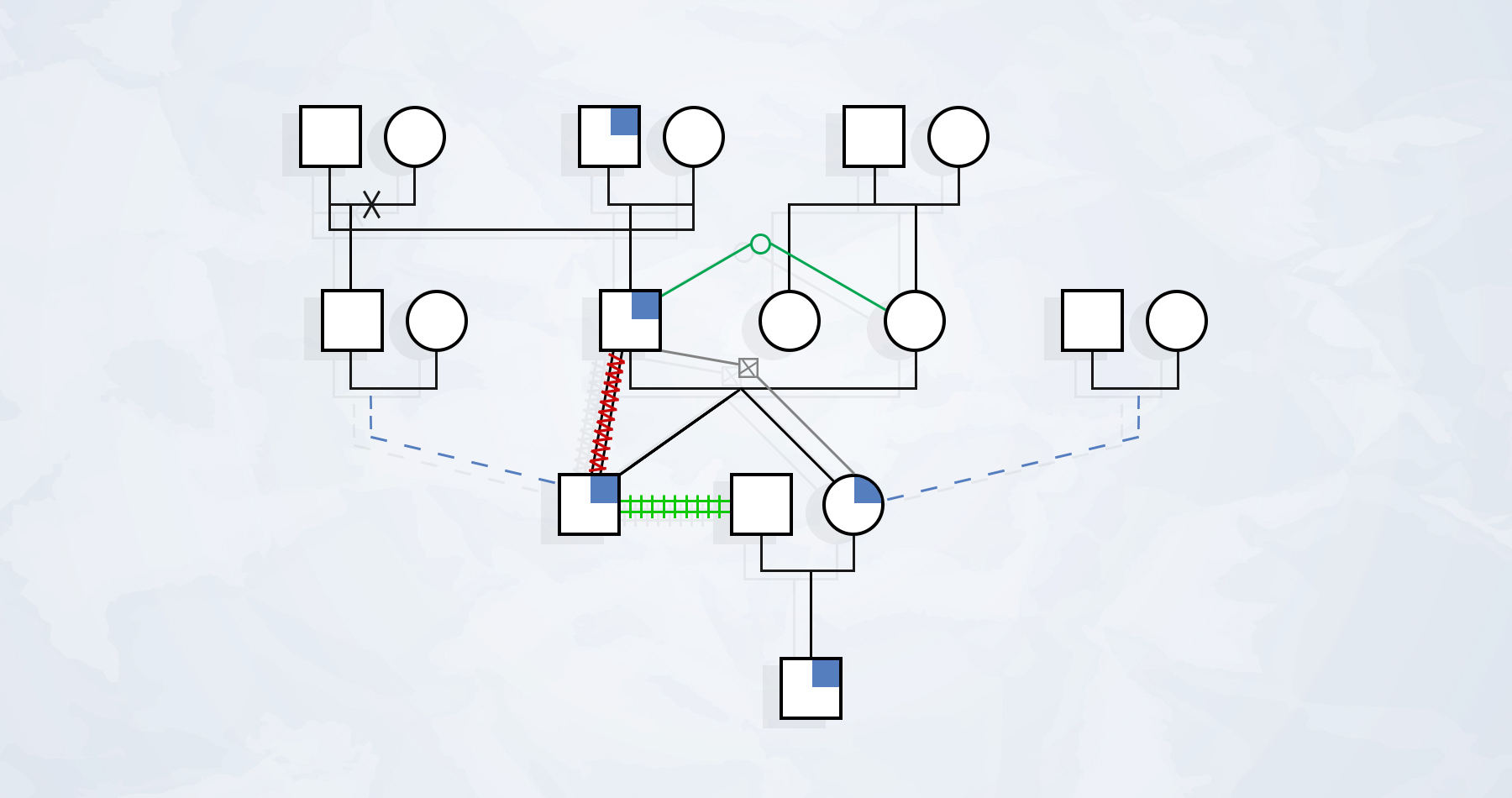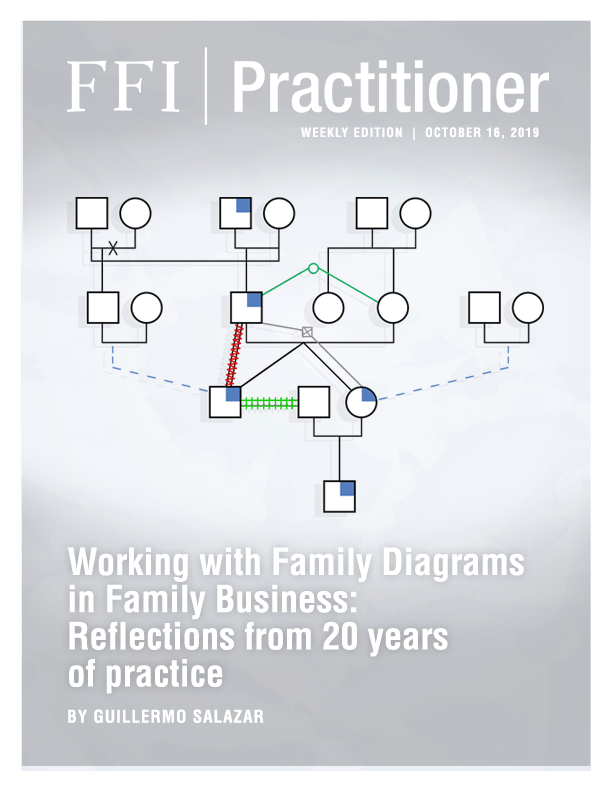
Based on the concept that the family of origin is the greatest influence every individual experiences from birth, these diagrams help professionals to become acquainted with the system structure and the storytelling of the lives of the individuals and families they work with. Family Diagrams have the ability to simplify the complexities of family relationships. They can help both the advisor and the family client to identify the strengths of the system and the aspects to be improved, to depict the situation confronting the family, to contextualize facts, and to identify key issues to be addressed within the family system. When helping the family to place these elements in the proper context and to make conscious what was previously unconscious, every individual enhances its probabilities to find the communication resources and willpower necessary to overcome the relational obstacles in their way, continuing forward in their own evolution.
A Little History
Literary sources credit Murray Bowen as the father of the Family Diagram concept for therapeutic purposes, developing it at the beginning of the 1970s to support his theory of family systems. Later work, such as the study of genograms led by Monica McGoldrick in 1999, increased its popularity beyond the clinical environment, supporting the need to have a tool to include and communicate information from one professional to another in multidisciplinary teams working with more complex systems (like family businesses) – much like how an orchestra is comprised of different musicians and instruments performing a musical piece in a coordinated and harmonic manner by using the same score.
Techniques
Of all the different techniques of expression, I personally prefer the classic paper and pencil drawing of the standard elements. From my experience, there is nothing more concise and direct to detect the feelings linked to our relationships than the stroke of our own hand. All of our aspirations, frustrations and expectations can be deduced from the slant of our lines, the use of space upon the page, the strength, force and thickness of our strokes, the size of each person depicted, the incidence of gravity force in the composition, the textures, the direction of the lines, the balance, the distribution, the tension, the selection and deletion in the chosen elements… even the erasures! Nothing escapes from a Family Diagram drawn by our own fist and wrist as a graphic work into which we pour our lives and the influence of our ancestors.
“It is my belief that one of our principal functions as agents for change in the system we work with is helping families detect those negative patterns which prevent them from evolving as a group or as individuals by facing situations in a courageous, original way not beholden to the past, freeing them from what we could all a family karma.”
The Role of the Advisor
I have learned that, as an external therapeutic unit of the family system, advisors have to be sufficiently humble and respectful in order to achieve the necessary level of connection with the individuals or family when constructing the Family Diagram. We must ask the appropriate questions (after all, that is what systemic thinking is about!) and without value judgements, allow our experience and intuition to guide us in the collective discovery of the origins of the possible conflicts of the system in all its magnificent complexity. It is my belief that one of our principal functions as agents for change in the system we work with is helping families detect those negative patterns which prevent them from evolving as a group or as individuals by facing situations in a courageous, original way not beholden to the past, freeing them from what we could all a family karma.
Questions like “Who are most alike personality-wise in each generation?”; “Which names repeat within the family?”; “What was the historical, economic and social context surrounding a given event?”; “Who are the entrepreneurs in the family?”; “What do they know about their grandparents’ lives?”; “What role have women played in their family’s history?”; can help us to find the keys to untangling the origins of behaviors which are no longer currently justified and which need to be overcome as lessons learned.

Recommended Methodology
As advisors to family firms, when working with Family Diagrams, my recommendation is to draft a tree of links, using the standard symbols for people by gender, including a minimum of three generations, with basic information about the family members (names, ages, year of birth and death) and their relationships (engagements, marriages, separations). We may later include, for example, the influence of the family firms and of non-family members that have had an impact in their history. The idea is to dismiss the unnecessary, adding all the information useful to us in order to understand their situation and to use it to perform an intervention, gather information for analysis or for sharing with the working-group.
We may also add notes regarding complex or toxic relationships, triangulation in communications, diseases, addictions, or scapegoats. If we include elements of the family’s storytelling, we might find how the family reacts to nodal events and its capacity to adapt in a new scenario, the handling of crises, the evolution of relationships, and agreed-upon solutions or notions of winners and losers. All of this can help us to detect patterns of behavior which remain in the family’s culture as part of its mythology and are transmitted from generation to generation through their own collective unconscious, repeating (for good or ill) the same responses to similar stimuli over and over, allowing us, from our external perspective, to help our client to foresee their reactions to future events.
But be aware: It is my advice that we must be very cautious and respectful regarding the way we share the different elements of information. Accessing data by certain individuals or families that are not ready to assimilate it, could create a problem instead of a solution. Quoting David Bork, “The Family Diagram is a powerful tool to tease up information. Use it carefully, you only have one chance to help your family client.” 1
Sidebar

Join Guillermo Salazar, chair of the 2019 conference program committee, in Miami. 2019 marks fifty years since “one giant leap” took us to the moon. The race to space was a study in global competition, ingenuity, innovation, embracing risk and imagining the impossible.
Some Final Thoughts
I have been drawing Family Diagrams for more than 20 years as a tool for supporting therapy interventions, advising processes, and training courses for professionals who work, or wish to work, for families from diverse regions around the world. Though the elements in a Family Diagram give us a standardized method of graphic representation, no one family is like any another (it may even change in time for the same family). Each individual family is a story and each story is a Family Diagram full of sentiments, dreams, and hopes which each client or student has generously shared with me or my professional team. I have gotten to know and understand their points of greatest pride, but also the events of greatest pain, always in a respectful way and with a therapeutic perspective, trying to help them to find, within their self-drawn riddle, the keys to the answers to their own questions, discovering together the paths that they must walk in search of their growth as individuals and as a family.
Reference
1 Macias, J. (November 5, 2014). Family Harmony Myth in Spain and Latin America. The Practitioner. The Family Firm Institute, Boston, MA.
Recommended Bibliography
Bowen, M. (1991). De la familia al individuo (English tittle: The Individual Family). Barcelona, Spain, Paidós.
Harrison, V. (2018). The Family Diagram & Family Research: An illustrated guide to tools for working on differentiation of self in one’s family. Houston, TX, CSNSF.
Hilburt-Davis, J. & Dyer, W. (2003). Consulting to Family Businesses: A practical guide to contracting, assessment, and implementation. San Francisco, CA. Jossey-Bass/Pfeiffer.
McGoldrick, M., Gerson, R. & Petry, S. (2008, 3rd Edition). Genograms: Assessment and intervention. New York, NY. Norton.
Minuchin, S., Fishman, H. (1981). Family Therapy Techniques. Cambridge, MA. Harvard University Press.
The Family Firm Institute (2014). Family enterprise: understanding families in business and families of wealth. Hoboken, NJ. Wiley.

Guillermo Salazar is the founder and managing director of Exaudi Family Business Consulting. Guillermo is a lecturer, educator, author, and expert advisor on family governance, strategic succession planning, generational transition and conflict resolution. He is an FFI Fellow, former FFI board member, and a member of the GEN (Global Education Network) faculty. Guillermo is the recipient of the 2015 FFI International Achievement Award and the chair of the 2019 Global Conference Program Committee. He can be reached at guillermo.salazar@exaudionline.com.
Established in 2010, Exaudi Family Business Consulting specializes in advising business families through their processes of professionalization, generational succession, and legacy transmission.
Related Article

“Flocks, Families and Organizations: Emerging applications from Bowen theory and science” by Mariana Martinez

“Interdependent Wealth: How Family Systems Theory Illuminates Successful Intergenerational Wealth Transitions” by Steve Legler

